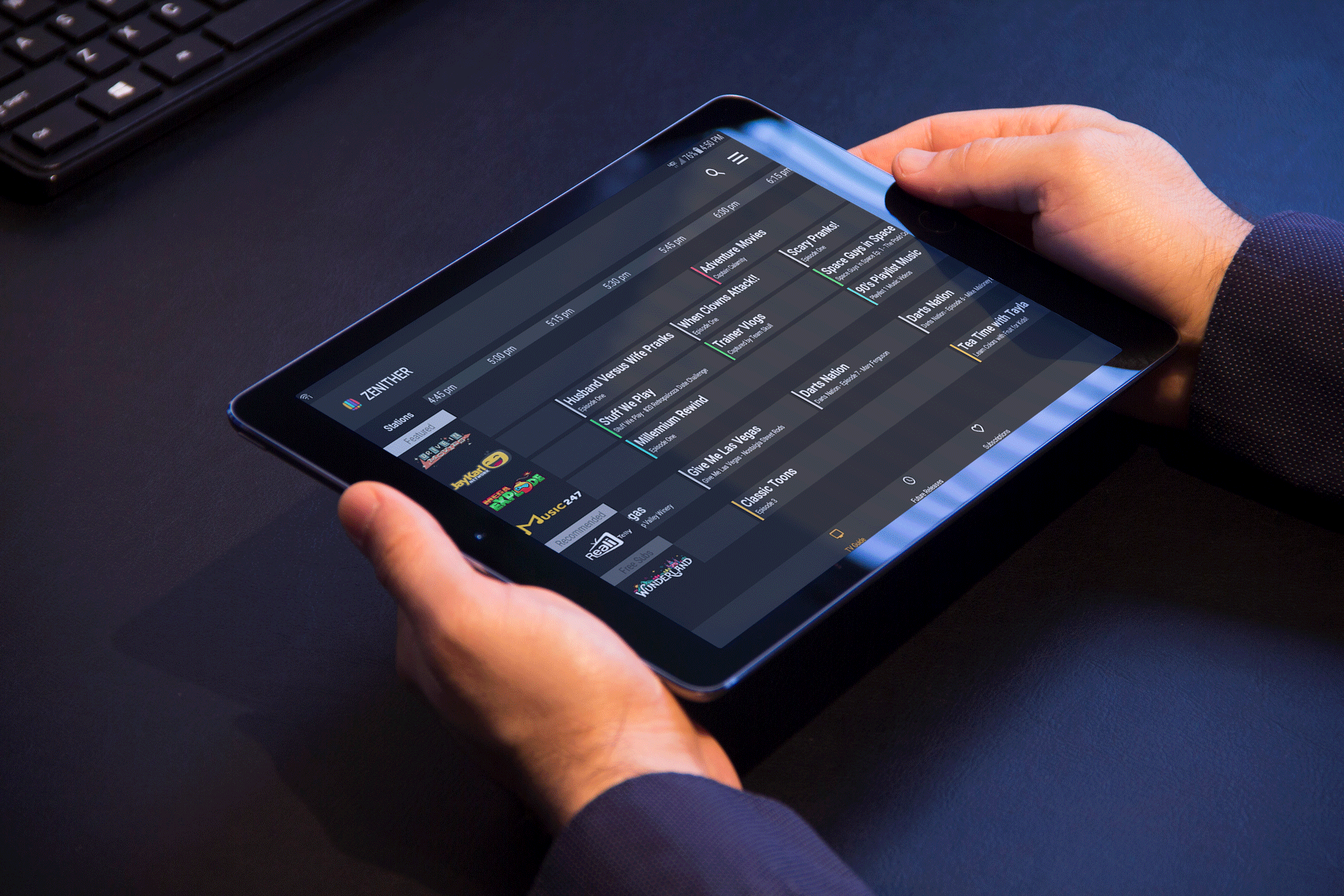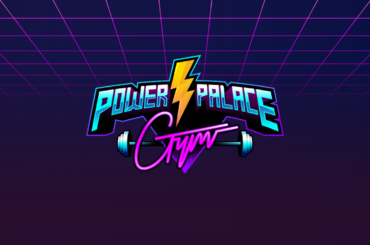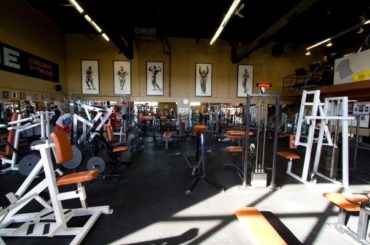Intro:
With our Zenither TV Anywhere platform we have built “cable TV without the cable“. We believe our technology can allow us to be the #1 TV carrier in the world. This is a boastful statement but it is one based upon the strength of the technology which we have imagined and engineered. It’s not a hypothetical; right now we are doing TV broadcasting in a way that nobody else is doing it and which we believe is the future way all TV broadcasters will operate.
You can find a pretty detailed demo of how our Publisher tools work by watching the following video:
The Quick and Dirty Explanation of What Dynamic TV Broadcasting is
The vast majority of OTT apps built by our competitors are a Netflix clone (Hulu, Amazon Prime, practically every OTT SaaS vendor you see at NAB Show, etc). These apps are functionally very similar to audio music playback software in that they organize video content into playlists with some search functionality to locate specific files. These apps can be thought of as virtual iPods playing movies and TV shows instead of songs, and YouTube is actually very similar in this regard as well — whereas it does have ‘channels’ these channels are really just a playlist of a specific creator’s content and they don’t replicate in any way the experience of a traditional TV channel. If Netflix is a virtual iPod of movies then YouTube is a virtual iPod of video blogs.
On the other side of the field we have virtual multi-channel video programming distributor (vMVPD) apps such as Sling TV, YouTube TV, DirecTV Now and so forth, that are fundamentally the same software in your cable set top box because they do essentially the same thing as these set top boxes do. These apps are primarily designed to repeat live video feeds down-linked from satellites, which in turn are fed by a large transmitter dish from a TV station which is the originating source of the video feed. Some of these apps may also be able to accept Media RSS feeds of pre-recorded video assets for delivery of “on demand” content to viewers.
Zenither is different from either of these aforementioned types of OTT apps, though of the two types we are closest to a vMVPD.
While we do support the streaming of a single live video feed (our simulcast stations) for certain stations, we primarily deliver video content for a station using a patent pending process we call “Dynamic Television Broadcasting” that eliminates the need for satellites, repeater stations, CDNs, third party broadcast automation software, time delay systems, DVR, etc. Pretty much 90% of what goes into traditional TV broadcasting is eliminated by Dynamic TV Broadcasting.
Likewise a viewer who is watching television content at home never needs to “DVR” content and can simply scroll back on the electronic programming guide to watch shows released earlier that day. There is no need to tell the Zenither system that you want to “record” a show to watch it later; all episodes released are instantly available for on-demand viewing.
I stress again; with Zenither’s Dynamic TV broadcasting system the latest episodes of a show are available for search / on demand viewing the moment they appear on the viewer’s EPG. This creates a profoundly improved user experience for audiences as they never need to setup a DVR system again.
Now the word ‘Dynamic’ as an adjective means “a process or system characterized by constant change, activity, or progress“. Dynamic TV broadcasting is a method of digital broadcasting which allows the individual segments of content that are delivered to audiences to be adjusted in real-time based on factors such as geographic location, time zone or personal data of the account used to watch the feed. Furthermore, unlike with all other kinds of internet based broadcasting our dynamic system stitches several video players into a feed.

The easiest way to understand how we are different is that existing websites like YouTube and Twitch utilize a single video player loaded on the viewer’s computer screen that has content streamed into that single player. This means that all viewers of the stream see the same video segments fed into that player with no way to make adjustments and display different content segments to different viewers.
By contrast a single half hour broadcast of content on Zenither can load dozens of video players, in some cases these video players originating from several different hosts, some of which can serve different content to different users. This is similar to a video playlist but quite different as the specific video players in this playlist can be dynamically changed based on many factors as determined by the broadcaster, and the playlist might contain an infinite number of video players within it.
The advantages of this format are many, and include (but are not limited to):
- Scale-ability: Video content can be pulled from multiple sources to create a single broadcast stream without any need to ship or send files around to load in broadcast automation systems. Everything can just sit in the cloud.
- Control over the narrative experience: The broadcaster can ensure it is impossible for the viewer to “skip ahead” to watch the end of programs released, ensuring the story is told the way that film’s makers intended the story to unfold for the viewer.
- Ensure that ads play for all views: With dynamic broadcasting the broadcaster can ensure their monetization model works in a predictable way. Standard methods of ad blocking software will not work against dynamic TV broadcasting, since…
- It is challenging for ad blocking software to know what upcoming video players will load and which will contain ads since this info is not available until the moment of broadcasting such content.
- Trying to “skip” an ad using ad blocking software will break the entire broadcast feed resulting in distortion of time codes which triggers a ‘test card / standby video’ error message to be played to the viewer.
- Lowers cost of distribution: Traditional methods of delivering streaming video waste bandwidth, often serving and storing large amounts of data which must be loaded for every viewer regardless of whether they are interested in “rewinding” the timeline to look at earlier broadcasts or not. Dynamic TV broadcasting will by contrast only load the segments of content the individual viewer is interested in seeing. The system also simulates time-shifting and serving of content to specific geo-locations without the need for the carrier to record an entire broadcast as video files, which already exist as video files in the originating server to start with. The carrier can simply use the originating video files from the broadcaster to serve content to any region of the world they like and customize the feed as needed.
- Live broadcasts do not need to be repackaged: A live broadcast of something like a news or sporting event using other systems would need to be manually re-edited to remove the TV commercials which first aired during the program. With Dynamic TV broadcasting there are no specific ads but rather ‘ad segments’ which can serve any kind of ad on initial or later broadcasts without any further editing needed than what happened during the initial live TV broadcast.

This dynamic aspect of the broadcast also applies to how advertising is served. Already many video advertisements are served in a dynamic way on websites like YouTube, Facebook and Hulu — the ads are served based on targeting filters which the viewer fits, so the ads that one person sees from the video are typically different than those other people see. The ads delivered are tailored to that person’s account. Likewise Dynamic TV broadcasting is capable of the same thing.
Where Dynamic TV broadcasting is unique is that unlike serving a single 30 second ad tailored to the person watching, creating 24/7 linear feeds of content which have this same ability has many unique technical challenges that required brand new solutions to be created. You have to consider everything from how to allow a programming director to configure the rules for what content is shown and who it is shown to. You have to consider the system’s ability to ensure standard time formats are followed so the linear feed doesn’t break. Unlike YouTube or Hulu which might show a commercial break of variable duration (some users may see a 15 second ad preroll, while others see a 2 minute skippable ad preroll) the time allotted for a commercial break on Zenither must be consistent across all the linear feeds delivered to the user. If this doesn’t happen then a live broadcast of something like a sporting event ends up with a long delay, so a person may be several minutes behind in the latest events happening during this live event compared to the folks watching in the stadium bleachers. With our Dynamic TV broadcasting system there is no need for artificial delays at all.
Dynamic television broadcasting has additional secondary advantages. The first is that audiences no longer need to use recording technologies like DVR ever again. Once a new episode has been released on Zenither it is instantly available for on demand watching. If you started watching an episode 5 minutes into its premiere broadcast you can “reset” the episode to watch from the beginning at any time. You can also scroll back on the timeline to earlier hours in the day and watch the episodes as they were released that day, including with the same ads that showed. You can also watch the episodes on later days and see different ads. This applies to both pre-recorded and live television broadcasts. There is never any need to manually re-edit a live recording to adjust it for new ad spots for future rebroadcasts, as the ad segment system used by Zenither is able to show different ads after the initial broadcast day has passed without the programming director needing to do anything additional.
So Dynamic TV Broadcasting has the following advantages over other kinds of OTT broadcasting, such as those which deliver a single HLS feed:
- Lowers number of hours spent building linear feeds.
- Eliminates the need to use antiquated technologies like satellite systems, repeater stations, time shifting video recording systems, DVR, etc.
- Reduces the skills and positions needed to be a television broadcaster. If you can schedule posts on Facebook you can now be a TV programming director.
- Eliminates countless hours of re-editing content for release on different days. Episode containers are re-usable and saves a tremendous amount of time when creating a broadcasting schedule.
All of this results in lowering the amount of money needed to start and operate a national or worldwide TV network.
Removing the need to employ DVR technologies also creates a simpler user experience. People don’t have to worry about hard-drive space on their devices and remembering to pre-configure episode recordings, or worry about missing a show if the power goes out in their apartment during a storm because their device wasn’t able to record the live feed from a satellite dish. This also means the amount of time someone may spend setting up their DVR system to record their favorite shows can now be spent doing other more productive things.
Lastly because the channel operator does not need to own traditional broadcast equipment nor lease space on a satellite to distribute their content it is possible for virtually anyone to run a TV network if they have enough content to broadcast 24 hours a day. The Zenither platform’s interface for a publisher account includes broadcast automation software designed to deliver Dynamic TV feeds and this software can be ran using a laptop.
It does not even need to be a good laptop. So instead of spending tens of millions of dollars on traditional broadcast equipment you could just spend $200 on an Acer Chromebook. The potential disruption to the TV broadcasting industry we’re bringing about is unprecedented.
Background on the Invention of Dynamic TV Broadcasting:
I don’t possess a background working in the traditional TV sector. As a child I grew up on my grandparent’s farm in Oregon and when I was seventeen years old I joined the US Army. When I got out of the service in January 2015 after serving a tour of duty during Operation Iraqi Freedom I had to try to figure out what to do with the rest of my life and stumbled into film-making, something which I had always been interested in pursuing since I was a child. At the time Myspace and YouTube were launching video platforms, and I came to the belief that internet based distribution of TV content was the future. So I started my own YouTube channel, which eventually evolved into starting a multi-channel YouTube network.
The triggering factor for me in imagining the system that would become Dynamic TV Broadcasting was when YouTube made a significant layout change in 2012. Like the majority of users I greatly disliked it and started thinking about how it could have been better, and what kinds of features could have been included in a new version of YouTube. I thought about stitching several video players back to back to create a virtual TV broadcast feed and how that might work in both content programming and user experience. I spent time researching how traditional broadcasting worked and how network programming directors used a variety of clever techniques and strategies to drive viewership to different shows on their network. I became convinced the ability to utilize these techniques was missing from YouTube and other similar sites, and needed to be implemented so that digital TV networks could operate like traditional TV networks did.
Funnily enough around this time I had been invited to YouTube’s headquarters in San Bruno, CA to give feedback on the G+ integration between YouTube and its new Google Plus (G+) service. During the open forum section of the presentation I openly asked why YouTube doesn’t make a system to allow for YouTube channels to create a 24/7 broadcast feed from multiple playlists. I was told by the representative hosting the open forum that “Google is a search company who believes search is the best experience” and “a human curated linear feed would be a step back in progress that had been made with recommendation engines.”
So because YouTube clearly wasn’t going to ever implement my idea I decided that I would need to do it myself if I wanted to someday use a system like it to help promote the videos in my network.
I would end up calling these special playlists Episode Containers.
I had the idea that several YouTube videos could be organized into a special kind of playlist that would play each video back to back, stitching several segments together from multiple YouTube accounts to create a real “TV network” on YouTube.
On December 29th 2012 I released a video on my YouTube channel detailing some of the wireframes and details I had been working on for how the app would work and function. I borrowed money from my mother to create a demo of how the software would work, believing it would help me find investors if I could show them what I was thinking. I was calling this system ‘Martell TV’ because I couldn’t think of a good name for it at the time.
Later in Feb 14th 2013 I released videos alongside a crowdfunding campaign showcasing the demo of the application which had been created.
Later I released several videos as slight improvements were made to the demo, such as this one on June 19th 2014 when I attempted another crowdfunding campaign for it, but ultimately I was unable to convince people to help me fund the project to where it could be a workable product for the masses.
After these failures I focused on growing the YouTube MCN Power Up TV (which I would eventually sell to Thunder Studios in January 2015 and become a Vice President there) and did not revisit the TV Anywhere app system until after I left Thunder in September 2015, whereupon I (still under a non-compete agreement preventing me from starting another YouTube network or working for one) was left to re-evaluate my idea for the ‘Martell TV’ app. I purchased an older RV, installed solar panels on it and then drove around the desert states of Texas, Arizona, New Mexico and California while trying to figure out the next steps.
I spent a great deal of time reading many books about the film and TV industry while also evaluating the other video streaming platforms and apps which had launched over the past year (in some cases the apps being near identical copies of the Martell TV app….). I knew I would need to make my app even better now in order to compete against the new wave of OTT apps now on the market and those that were announced to come.
So over the many months of 2016 I made several critical tweaks to my design documents for the way the app would work and these tweaks would result in Dynamic Television Broadcasting and all of its unique features being born. During my time in the RV I had written some books about how to build a business on YouTube and start MCNs, which brought me many people interested in hiring me as a consultant for their companies. So I started working as a consultant in January 2017 and saving money for re-starting development on the app, which I would now call Zenither. In June of that year I would be hired as a consultant by a company owned by Mr. Akim Anastopoulo, and he liked what I was doing with Zenither so much he wanted to invest into Martell Broadcasting Systems, Inc. to help bring the product to market. We also conducted a Reg A+ crowdfund campaign through Start Engine.
Over a year and several months later working with our engineering team at Scio, we released the open beta version of Zenither’s Android and web browser apps in July 2018 and the iOS app on the last weekend of September 2018.
What’s Next?
Dynamic Television Broadcasting as described in this article is really just a very simplified version of all its possibilities for the future of broadcasting. We have a very innovative and highly disruptive product already but there are still several additional enhancements and features I believe are possible which will greatly expand its efficiency and uses. I hope to be able to share and talk about these things in the coming months.
If you’re interested in talking to us about becoming a channel operator on Zenither, please contact us.
I hope you found this article informative.




